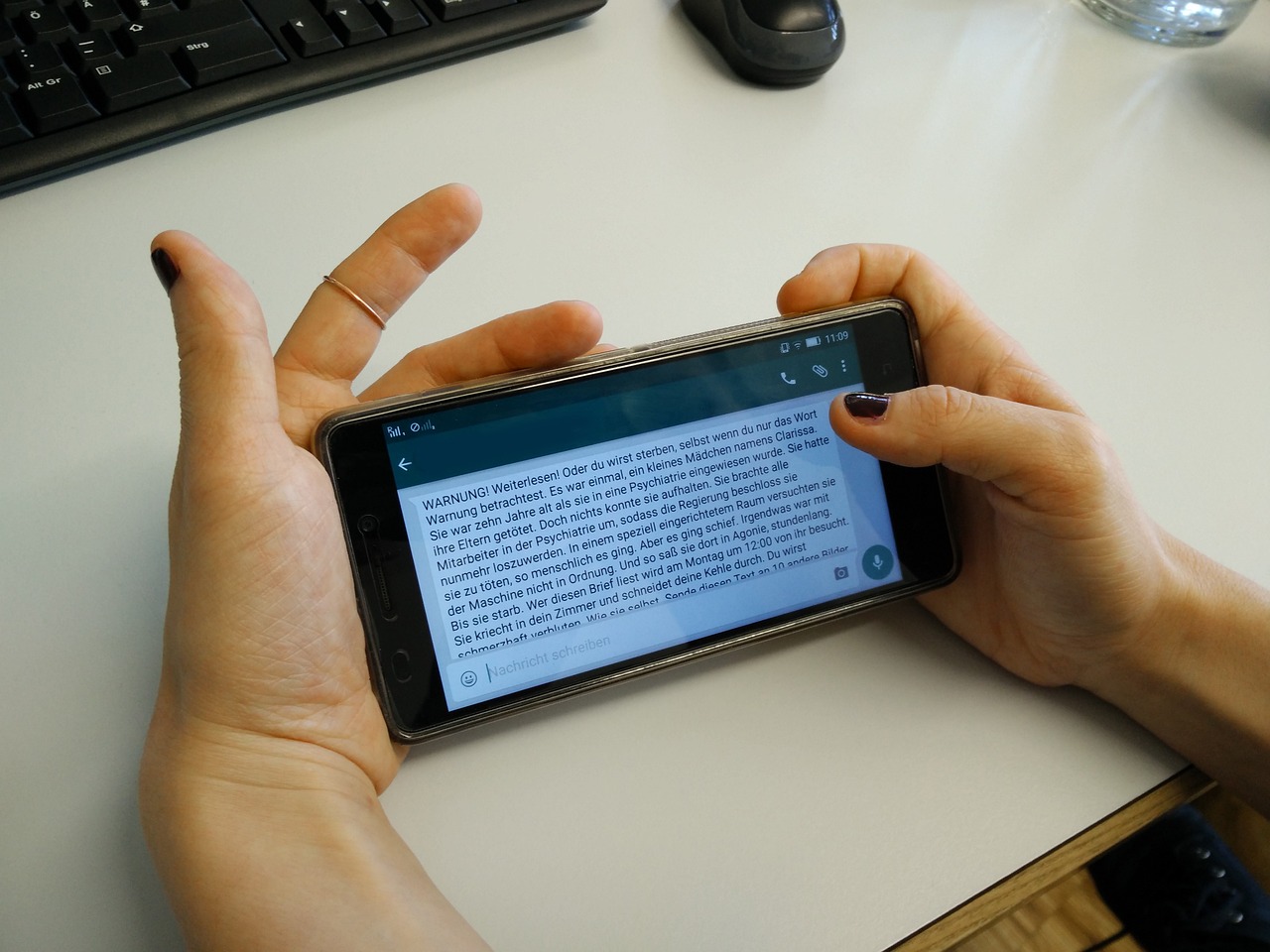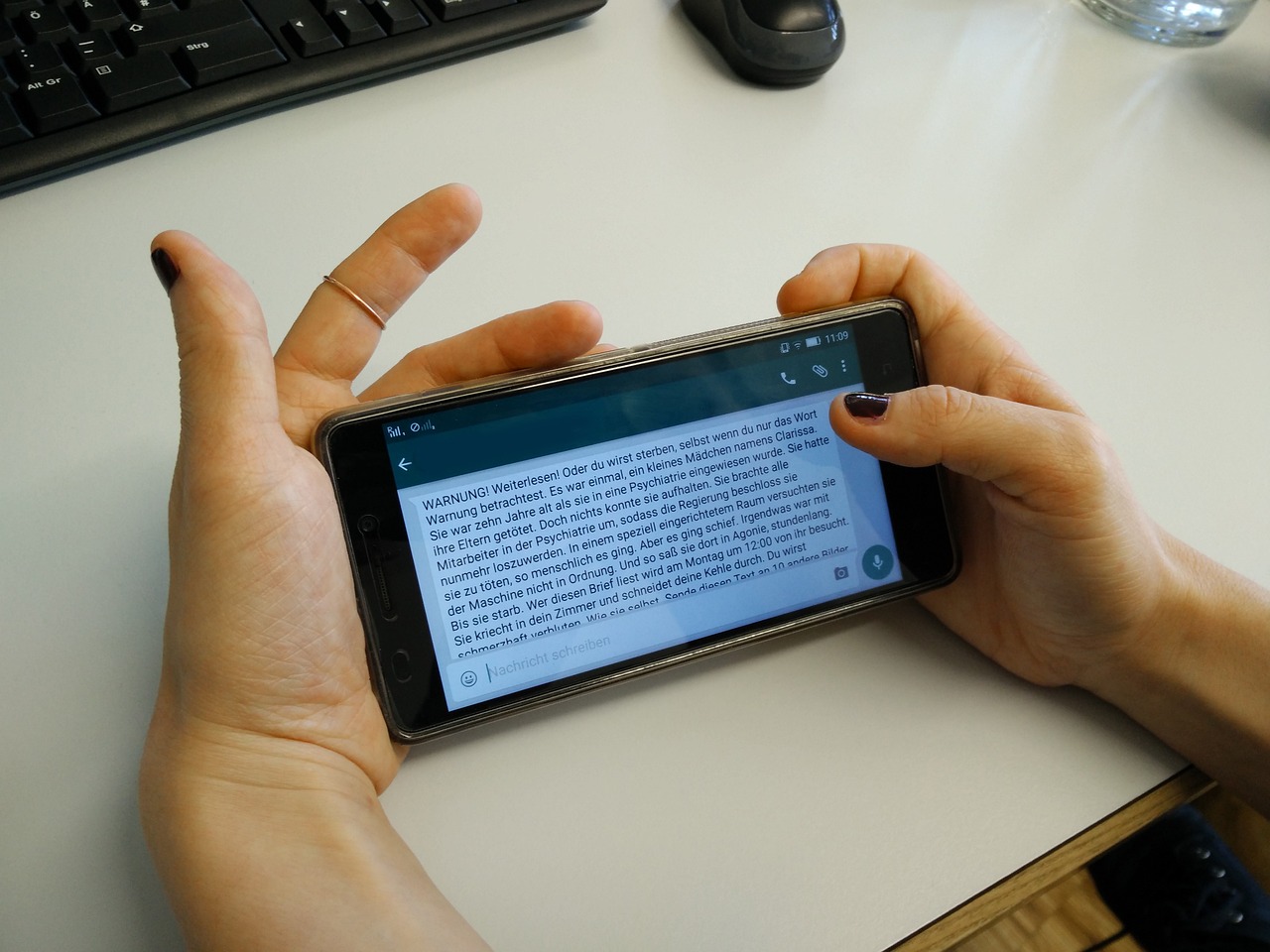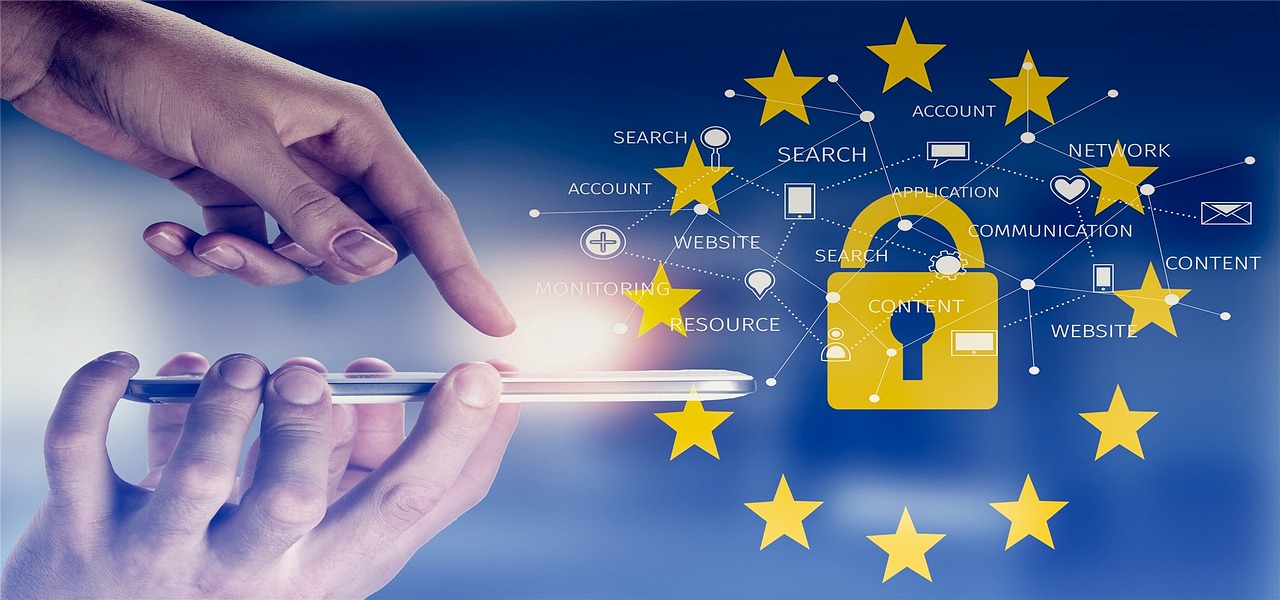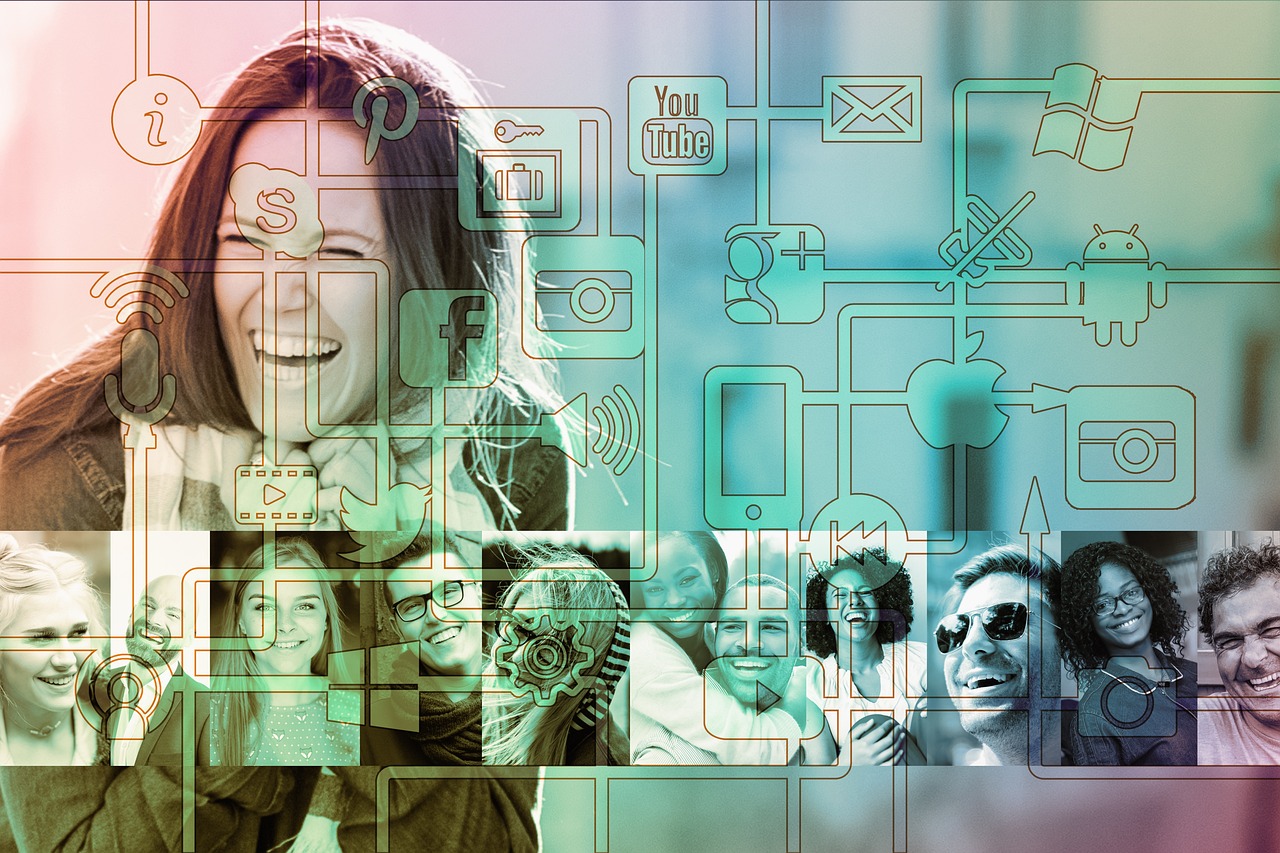10 Most Common Risks in Online Social Networking
In today's digital age, online social networking has become an integral part of our lives. From connecting with friends and family to sharing experiences and ideas, these platforms offer a plethora of opportunities for interaction. However, with great connectivity comes great responsibility, and the risks associated with social networking can be quite alarming. In this article, we will explore the 10 most common risks that users face while navigating the vibrant yet perilous waters of social media. Understanding these risks is crucial for anyone who wants to enjoy their online experience while minimizing potential dangers.
One of the most pressing risks in social networking is the issue of privacy. Many users often share personal information without fully understanding the implications. This can lead to unauthorized access to sensitive data, which can be misused in various ways. For instance, oversharing can expose users to identity theft, stalking, or even harassment. To safeguard personal data, it is essential to familiarize oneself with privacy settings offered by social media platforms. These settings allow users to control who can see their posts, personal information, and friend lists. A good rule of thumb is to ask yourself, "Would I be comfortable if this information were shared with strangers?" If the answer is no, it's best to keep it private.
Another significant risk that has emerged in the realm of online social networking is cyberbullying. This form of bullying can take many shapes, from hurtful comments and harassment to spreading rumors and exclusion. The impact of cyberbullying is profound, affecting not only the victim's mental health but also their overall well-being. It's crucial to recognize that the anonymity of the internet can embolden individuals to act in ways they might not in person, leading to a toxic environment for some users.
Recognizing the signs of cyberbullying is essential for prevention. Common behaviors that may indicate someone is a victim include:
- Sudden changes in mood or behavior
- Avoidance of social interactions
- Frequent complaints about online interactions
- Loss of interest in previously enjoyed activities
If you notice these signs in yourself or someone else, it's vital to take action.
The emotional and psychological effects of cyberbullying can be severe. Victims may experience heightened levels of anxiety, depression, and a significant decline in self-esteem. The feeling of being constantly watched or judged online can lead to a sense of isolation, making it even more challenging for victims to seek help. It's important to remind ourselves that behind every screen is a real person with real feelings.
Knowing how to report cyberbullying and seek support is vital. Many social media platforms have built-in reporting features that allow users to flag inappropriate behavior. Additionally, reaching out to trusted friends, family, or professionals can provide a support system for those affected. Resources such as hotlines and online support groups can also be invaluable in navigating these tough situations.
To protect oneself from becoming a victim of cyberbullying, users can implement several practical strategies. Setting clear boundaries about what to share online and utilizing privacy settings effectively can significantly reduce exposure to potential harassment. Additionally, fostering a positive online community by unfollowing toxic accounts and engaging with supportive friends can create a more enjoyable social networking experience.
Identity theft is another growing concern in social networking. With the amount of personal information shared online, it becomes all too easy for malicious actors to exploit this data. Users must understand the risks associated with sharing personal details and take preventive measures to protect their identities. Simple practices, such as avoiding sharing sensitive information like addresses or phone numbers publicly, can go a long way in safeguarding personal data.
Identity thieves often employ various tactics to gather personal information from unsuspecting users. These may include:
- Phishing scams, where users are tricked into providing personal information through fake websites or emails.
- Social engineering, which involves manipulating individuals into divulging confidential information.
- Data breaches, where hackers gain unauthorized access to databases containing personal information.
Being aware of these tactics can help users remain vigilant and cautious while interacting online.
Implementing strong security measures can significantly reduce the risk of identity theft. Some effective strategies include:
- Using complex passwords that combine letters, numbers, and symbols.
- Enabling two-factor authentication for an added layer of security.
- Regularly updating privacy settings on social media accounts.
By taking these precautions, users can enhance their online security and enjoy a safer social networking experience.
Q: What should I do if I experience cyberbullying?
A: If you experience cyberbullying, document the behavior, report it to the platform, and seek support from friends, family, or professionals.
Q: How can I protect my privacy on social media?
A: Familiarize yourself with privacy settings, limit what you share publicly, and think twice before posting personal information.
Q: What are some signs of identity theft?
A: Signs of identity theft include unfamiliar transactions on your accounts, receiving bills for services you didn't use, or being denied credit unexpectedly.
Q: How can I report identity theft?
A: You can report identity theft to your local authorities, the Federal Trade Commission (FTC), and your bank or credit card company.

Privacy Concerns
In today's digital age, have become a significant risk associated with online social networking. With the click of a button, users can share a wealth of personal information, from their location to their daily activities, often without fully understanding the potential consequences. It's like opening a window to your life, but forgetting to close the curtains at night. What happens when that information falls into the wrong hands? The reality is that many users are unaware of how their data can be misused, leading to serious implications for their personal safety and security.
One of the first steps in safeguarding your privacy is to familiarize yourself with the various privacy settings available on social networking platforms. These settings allow you to control who can see your posts, send you friend requests, or even look you up using your email address. It's essential to take the time to explore these options and customize them according to your comfort level. For instance, did you know that you can limit your profile visibility to only your friends? This simple act can significantly reduce the risk of unwanted attention and potential threats.
Moreover, when sharing information online, it’s crucial to think before you post. Ask yourself: Is this something I want everyone to see? Even seemingly harmless details, such as your pet's name or the school you attended, can be pieced together by malicious actors to create a more complete picture of your identity. Cybercriminals often use a technique known as social engineering, where they manipulate individuals into divulging confidential information. This can happen through phishing attacks, where scammers impersonate legitimate organizations to gain access to your personal data.
To help illustrate the importance of privacy in social networking, consider the following table that outlines common privacy risks:
| Privacy Risk | Description |
|---|---|
| Oversharing | Posting too much personal information that can be exploited. |
| Location Tracking | Sharing your location can lead to stalking or unwanted attention. |
| Weak Passwords | Using easily guessable passwords makes accounts vulnerable. |
| Public Profiles | Having a public profile exposes your information to everyone. |
Additionally, it’s important to regularly review your friend list and remove any connections that no longer serve a positive purpose in your life. This practice can help minimize the risk of sharing your information with individuals who may not have your best interests at heart. Remember, just because someone sends you a friend request doesn’t mean you have to accept it. It's your digital space, and you have the right to curate it.
In conclusion, navigating privacy concerns in online social networking requires a proactive approach. By understanding privacy settings, being cautious about what you share, and regularly reviewing your connections, you can significantly enhance your online safety. In a world where information is power, protecting your personal data is not just wise—it's essential.
- What are the best privacy settings for social media? Always set your profile to private, limit who can see your posts, and review your friend list regularly.
- How can I tell if my information has been compromised? Look out for unusual activity on your accounts, such as unfamiliar login attempts or changes to your profile without your knowledge.
- What should I do if I suspect identity theft? Immediately change your passwords, notify your bank, and consider placing a fraud alert on your credit report.

Cyberbullying
This article explores the various risks associated with online social networking, highlighting the potential dangers users face and offering insights on how to navigate these platforms safely.
has become a pervasive issue in the realm of online social networks, affecting individuals of all ages, but particularly teenagers and young adults. It's one of those things that can sneak up on you like a shadow in the night, often leaving victims feeling isolated and vulnerable. In a world where we share our lives online, the lines between friendship and hostility can blur, making it essential to understand what cyberbullying looks like and how it can impact mental health and well-being.
So, what exactly is cyberbullying? It's when someone uses digital platforms—like social media, forums, or even text messages—to harass, threaten, or embarrass another person. Unlike traditional bullying, which often has a physical presence, cyberbullying can happen anywhere and at any time, making it feel inescapable. Imagine receiving a nasty comment on a photo you posted or being excluded from a group chat; these seemingly small actions can snowball into something much larger and more damaging.
The effects of cyberbullying are profound and can lead to serious emotional and psychological consequences. Victims often experience feelings of anxiety, depression, and a significant decline in self-esteem. The anonymity of the internet can embolden bullies, leading to more severe forms of harassment, which can escalate quickly. It's a vicious cycle that can leave victims feeling trapped and hopeless.
Recognizing the signs of cyberbullying is crucial for prevention. Some common behaviors that may indicate someone is being bullied online include:
- Withdrawal from social interactions or activities they once enjoyed.
- Sudden changes in mood or behavior, such as increased irritability or sadness.
- Frequent complaints about headaches, stomachaches, or other physical ailments without a clear cause.
- Becoming secretive about their online activities or devices.
If you notice these signs in yourself or someone you know, it’s essential to take them seriously. The sooner you address the issue, the better the chances of mitigating its effects.
The emotional toll of cyberbullying can be devastating. Victims often find themselves grappling with feelings of worthlessness and despair. The psychological impacts can manifest in various ways, including:
- Anxiety: Constant worry about online interactions can lead to heightened anxiety levels.
- Depression: The feeling of being targeted can spiral into deep depression.
- Decline in self-esteem: Repeated negative comments can chip away at a person's self-worth.
It's critical to recognize that these feelings are valid and that help is available. Victims should know that they are not alone and that there are resources and support systems in place to help them through these tough times.
Knowing how to report cyberbullying and seek support is vital. Most social media platforms have specific guidelines for reporting harassment. Users should familiarize themselves with these processes and not hesitate to use them. Additionally, reaching out to trusted friends, family, or mental health professionals can provide the necessary support to cope with the situation. Remember, taking action is a sign of strength, not weakness.
So, how can you protect yourself from becoming a victim of cyberbullying? Here are some practical tips:
- Set boundaries: Be clear about what you are comfortable sharing online.
- Use privacy settings: Familiarize yourself with the privacy settings on your social media accounts and adjust them to limit who can see your content.
- Think before you post: Always consider the potential consequences of your words and actions online.
By taking these proactive steps, you can create a safer online environment for yourself and others.
Q: What should I do if I see someone being bullied online?
A: If you witness cyberbullying, it’s essential to report it to the platform immediately and offer support to the victim. Encouraging them to talk to someone they trust can also be helpful.
Q: Can cyberbullying happen to adults?
A: Absolutely. While it is often associated with teens, adults can also experience cyberbullying in professional settings or through social media.
Q: How can I help a friend who is being cyberbullied?
A: Be there for them. Listen to their concerns, encourage them to report the bullying, and remind them that they are not alone in this fight.

Identifying Cyberbullying
Recognizing cyberbullying is crucial in tackling this pervasive issue that affects countless individuals across various social networking platforms. The digital landscape can often feel like a wild west, where anonymity emboldens some users to engage in harmful behavior without facing immediate consequences. But how can you tell if someone is being bullied online? There are several key signs to watch out for, and being aware of these can empower you to take action.
First and foremost, look for changes in behavior. If a friend or loved one suddenly withdraws from social media or becomes unusually quiet, it may be a red flag. They might also show signs of distress when using their devices, such as anxiety or anger. This change in demeanor can indicate that they are experiencing something troubling online. Additionally, if you notice them frequently deleting posts or blocking certain users, it could be a sign that they are trying to escape from a negative situation.
Another important aspect to consider is the content of their interactions. Cyberbullying often manifests through harassing messages, derogatory comments, or even the spread of false rumors. If you see a pattern where someone is consistently targeted with negative remarks or threats, it's essential to take it seriously. This behavior can take various forms, including:
- Direct insults: Comments that belittle or demean the individual.
- Impersonation: Someone pretending to be the victim to spread false information.
- Exclusion: Deliberately leaving someone out of group activities or discussions.
Moreover, keep an eye out for the social dynamics within the victim's online circles. If a group of friends suddenly turns hostile or begins excluding someone, it can be indicative of a larger issue at play. This type of social manipulation can be as damaging as direct attacks, leading to feelings of isolation and despair.
Lastly, it’s important to remember that the impact of cyberbullying can extend beyond the digital realm. Victims may experience a decline in their mental health, leading to anxiety, depression, or other emotional struggles. If you suspect someone is being bullied online, don’t hesitate to reach out to them. Sometimes, just knowing that someone cares can make a significant difference.
In conclusion, identifying cyberbullying requires vigilance and empathy. By being aware of the signs and taking them seriously, we can create a safer online environment for everyone. Remember, if you or someone you know is facing this issue, support is available, and it’s okay to seek help.
Q: What should I do if I suspect someone is being cyberbullied?
A: If you suspect someone is being cyberbullied, reach out to them and offer your support. Encourage them to talk about their experiences and suggest reporting the behavior to the platform’s administrators.
Q: Can cyberbullying happen in private messages?
A: Yes, cyberbullying can occur in private messages, and it can be just as harmful as public harassment. Always be alert to the signs, even in private communications.
Q: What resources are available for victims of cyberbullying?
A: There are various resources available, including hotlines, counseling services, and online support groups. Many social media platforms also have reporting tools that can help address bullying behavior.

Effects on Victims
The emotional and psychological toll of cyberbullying can be profound and long-lasting. Victims often find themselves trapped in a cycle of negativity that can significantly impact their daily lives. Imagine waking up each day, dreading the thought of logging into your social media accounts, fearing the onslaught of hateful messages or derogatory comments. This is the reality for many individuals who face online harassment. The effects can manifest in various ways, and understanding these impacts is crucial for both victims and their support networks.
One of the most immediate effects of cyberbullying is the rise in anxiety levels. Victims may experience constant worry about their online presence, leading to heightened stress and a feeling of being perpetually on edge. This anxiety can escalate into more severe mental health issues, such as depression. In fact, studies have shown that those who are targeted online are at a higher risk of developing depressive symptoms, which can lead to a decline in overall well-being.
Moreover, the impact on self-esteem is particularly concerning. Victims may start to internalize the hurtful comments and messages they receive, leading to feelings of worthlessness and self-doubt. It's akin to carrying a heavy backpack filled with rocks; each hurtful comment adds another rock, making it increasingly difficult to stand tall and confident. This decline in self-esteem can affect various aspects of life, including relationships, academic performance, and social interactions.
In addition to emotional struggles, victims of cyberbullying may also face physical health issues. The stress and anxiety can lead to sleep disturbances, headaches, and even gastrointestinal problems. It's essential to recognize that the mind and body are interconnected, and the effects of cyberbullying can ripple through every aspect of a person's health.
To illustrate the severity of these effects, consider the following table that outlines common emotional and psychological impacts faced by victims of cyberbullying:
| Effect | Description |
|---|---|
| Anxiety | Constant worry and fear about online interactions and safety. |
| Depression | Feelings of sadness, hopelessness, and a lack of interest in activities. |
| Low Self-Esteem | Negative self-image and feelings of worthlessness. |
| Physical Health Issues | Stress-related symptoms such as headaches, stomach issues, and sleep problems. |
Understanding these effects is vital for creating a supportive environment for victims. Friends, family, and peers can play a crucial role in helping individuals navigate their experiences. Encouraging open communication, offering emotional support, and promoting professional help when necessary can make a significant difference in the recovery process.
In conclusion, the effects of cyberbullying extend far beyond the screen. They can alter a victim's emotional landscape, impact their physical health, and reshape their self-perception. It is essential to foster awareness and empathy in our online communities to combat these negative effects and support those who are suffering.
- What should I do if I am being cyberbullied? It's important to document the harassment, report it to the platform, and seek support from friends or professionals.
- How can I help someone who is a victim of cyberbullying? Offer your support, listen to their experiences, and encourage them to seek professional help if needed.
- Are there any legal actions I can take against cyberbullying? Yes, depending on the severity of the harassment, you can report it to law enforcement or consult with legal professionals.

Reporting and Support
When it comes to dealing with cyberbullying, knowing how to report incidents and seek support can make a world of difference. The first step is to recognize that you are not alone; many people face similar challenges, and there are resources available to help. If you or someone you know is experiencing online harassment, it’s crucial to document everything. Take screenshots of the bullying messages, save posts, and note the dates and times of incidents. This evidence will be invaluable when you decide to report the behavior.
Most social media platforms have specific reporting mechanisms in place. For instance, if you're using Facebook, you can report a post or message by clicking on the three dots in the corner of the post and selecting “Report.” Similarly, Twitter allows you to report tweets directly from the tweet itself. Each platform typically has a dedicated section for handling harassment and abuse, so familiarize yourself with these options.
In addition to reporting the behavior on the platform, consider reaching out to trusted friends or family members. Sharing your experience can provide emotional support and help you feel less isolated. If the situation escalates or you feel threatened, don’t hesitate to contact local authorities. Cyberbullying can sometimes lead to serious consequences, and it’s essential to take threats seriously.
Furthermore, there are many organizations dedicated to helping victims of cyberbullying. These organizations offer resources, counseling, and sometimes even legal assistance. For example, organizations like StopBullying.gov and Cyberbullying Research Center provide valuable information and support networks. Here’s a quick overview of some helpful resources:
| Organization | Services Offered | Website |
|---|---|---|
| StopBullying.gov | Information on bullying prevention and resources | stopbullying.gov |
| Cyberbullying Research Center | Research, resources, and support for victims | cyberbullying.org |
| National Suicide Prevention Lifeline | Crisis support and prevention | suicidepreventionlifeline.org |
In conclusion, taking action against cyberbullying involves both reporting the behavior and seeking support from trusted individuals and organizations. Don't hesitate to reach out for help; there are people and resources ready to assist you in navigating this challenging landscape.
Q1: What should I do if I see someone being bullied online?
A1: It's essential to report the behavior to the platform and offer support to the victim. You can also encourage them to seek help from trusted friends or authorities.
Q2: Can I remain anonymous when reporting cyberbullying?
A2: Yes, many platforms allow anonymous reporting. However, providing as much detail as possible can help the platform take appropriate action.
Q3: What are the signs that someone is being bullied online?
A3: Signs may include sudden changes in mood, withdrawal from social interactions, or reluctance to use their devices. If you notice these changes, it’s crucial to check in with them.
Q4: Are there legal consequences for cyberbullying?
A4: Yes, in many jurisdictions, cyberbullying can lead to legal repercussions, especially if it involves threats or harassment. It’s essential to take such behaviors seriously.

Protecting Yourself from Cyberbullying
In today's digital age, where social media platforms are an integral part of our lives, protecting yourself from cyberbullying has never been more crucial. Imagine stepping into a bustling marketplace filled with people, but instead of face-to-face interactions, everything happens behind a screen. This anonymity can sometimes lead to malicious behavior. So, how can you safeguard yourself in this virtual world? Let’s dive into some effective strategies that can help you navigate these treacherous waters.
First and foremost, it’s essential to set clear boundaries on what you share online. Think of your personal information as a treasure chest; you wouldn’t want just anyone to have the key, would you? Limit the details you disclose about your life, such as your location, contact information, and even your daily routines. This not only protects your privacy but also makes it harder for potential bullies to target you.
Another crucial step is to familiarize yourself with the privacy settings on your social media accounts. Most platforms offer various options to control who can see your posts, comment on them, or even contact you. For instance, consider restricting your profile to friends only and reviewing friend requests carefully. If someone seems suspicious or you don’t recognize them, it's perfectly fine to decline their request. By taking these steps, you can create a more secure online environment.
Additionally, it’s vital to recognize the signs of cyberbullying early. If you notice a pattern of negative comments or messages directed at you, don’t brush it off as just "online banter." Instead, take it seriously. Document all instances of bullying by taking screenshots and saving messages. This can be invaluable if you decide to report the behavior later. Remember, you are not alone; many resources are available to help you.
Speaking of resources, knowing how to report bullying is an essential part of protecting yourself. Most social media platforms have built-in reporting features specifically designed for this purpose. If you encounter harassment, don’t hesitate to use these tools. They not only help you but can also prevent the bully from targeting others. Moreover, consider reaching out to trusted friends or family members for support. Sharing your experiences can lighten the emotional burden and provide you with valuable advice.
Lastly, always remember the importance of self-care. Engaging with social media can sometimes feel overwhelming, especially when dealing with negativity. Take breaks from the online world when needed. Spend time doing things you love, whether it’s reading a book, going for a walk, or simply enjoying time with friends. This can help you regain perspective and build resilience against online negativity.
In summary, protecting yourself from cyberbullying involves a combination of setting boundaries, utilizing privacy settings, recognizing signs of harassment, knowing how to report it, and practicing self-care. By taking these proactive steps, you can create a safer online experience for yourself and foster a more positive digital environment.
- What should I do if I am being bullied online?
Document the incidents and report them to the platform. Seek support from friends or trusted adults. - Can I block someone who is bullying me?
Yes, most social media platforms allow you to block users, preventing them from contacting you. - Is it important to talk about cyberbullying?
Absolutely! Discussing your experiences can help you process your feelings and find solutions. - Are there resources available for victims of cyberbullying?
Yes, many organizations offer support and guidance for those affected by online harassment.

Identity Theft
Identity theft is a growing concern in the realm of social networking, where the lines between personal information and public exposure can blur alarmingly. Every time you post a photo, share your location, or update your status, you might be unwittingly handing over a piece of your identity to cybercriminals. It’s like leaving your front door wide open while you’re away—inviting unwanted guests to rummage through your private life. Understanding the risks associated with identity theft is crucial for anyone who wants to navigate these platforms safely.
In the world of social media, identity thieves are constantly on the lookout for opportunities to exploit unsuspecting users. They employ various tactics to gather personal information, which can then be used to impersonate individuals, access financial accounts, or even commit fraud. It's essential to remain vigilant and aware of these tactics to protect yourself. For instance, thieves might use phishing scams, where they create fake profiles that mimic legitimate businesses or friends to trick you into providing sensitive information.
Furthermore, the information you share, whether it’s your birthday, address, or even your pet's name, can be pieced together like a puzzle, allowing thieves to gain access to your accounts. A simple post about your recent vacation could indicate to a thief that your home is unoccupied, making it a prime target for burglary. The importance of being cautious about what you share cannot be overstated. It’s not just about privacy; it’s about protecting your entire identity.
To help you understand the various tactics used by identity thieves, consider the following common methods:
- Social Engineering: Manipulating individuals into divulging confidential information.
- Malware: Installing malicious software on your devices to steal personal information.
- Data Breaches: Exploiting vulnerabilities in company systems to access user data.
Being aware of these tactics is the first step in safeguarding your identity. But what can you do to prevent identity theft? Implementing strong security measures is essential. Utilizing complex passwords, avoiding the reuse of passwords across different platforms, and enabling two-factor authentication can significantly enhance your online security. Think of these measures as the locks on your doors—essential for keeping intruders out.
Additionally, regularly monitoring your accounts and credit reports can help you catch any suspicious activity early. If you notice something amiss, such as unfamiliar transactions or accounts you didn’t open, act quickly. Report any fraudulent activity to your financial institutions and local authorities immediately. Remember, the sooner you act, the better your chances of mitigating the damage.
In conclusion, identity theft is a serious risk that comes with the territory of online social networking. By understanding the tactics used by thieves and implementing strong preventive measures, you can protect your identity and enjoy the benefits of social networking without fear. Stay informed, stay cautious, and remember: your identity is priceless—guard it fiercely.
- What should I do if I suspect my identity has been stolen? Immediately report the theft to your bank, credit card companies, and local law enforcement. Monitor your accounts closely and consider placing a fraud alert on your credit report.
- How can I create a strong password? Use a mix of uppercase and lowercase letters, numbers, and special characters. Aim for at least 12 characters, and avoid using easily guessed information like birthdays or pet names.
- Is it safe to share personal information on social media? Be cautious about what you share. Avoid posting sensitive information such as your address, phone number, or details that could help someone steal your identity.

Common Tactics Used by Thieves
When it comes to online social networking, identity thieves are like wolves in sheep's clothing, lurking in the shadows, waiting for an opportunity to strike. They employ a variety of cunning tactics to gather personal information, often making it seem innocuous. One common method is through phishing. This involves sending fake messages or emails that appear to be from legitimate sources, encouraging users to click on links that lead to fraudulent websites. These sites can look remarkably similar to real ones, tricking even the most vigilant users into entering sensitive information.
Another tactic is social engineering. This is where thieves manipulate individuals into divulging confidential information by exploiting trust or fear. For instance, they might pose as a friend or a trusted authority figure, creating a false sense of security that leads the victim to share personal details. It’s alarming how often this tactic works, especially when the thief has done their homework and knows just enough about the victim to make their story believable.
Moreover, thieves often utilize malware to gather information. This malicious software can be secretly installed on a victim's device, capturing keystrokes or accessing personal files without the user ever knowing. It’s like having a hidden camera in your home, recording everything you do. To protect yourself, always ensure that your devices are equipped with up-to-date antivirus software and be cautious of downloading unknown applications.
Lastly, public Wi-Fi networks pose a significant risk. Thieves can easily intercept data transmitted over unsecured connections, allowing them to snatch personal information like usernames and passwords. Imagine sending a postcard with your personal details written on it; anyone could read it while it’s in transit. To mitigate this risk, consider using a Virtual Private Network (VPN) when accessing sensitive information on public networks.
Here’s a quick summary of these common tactics:
| Tactic | Description |
|---|---|
| Phishing | Fake messages that trick users into providing sensitive information. |
| Social Engineering | Manipulating individuals into sharing confidential information. |
| Malware | Malicious software that captures personal data without consent. |
| Public Wi-Fi Risks | Data interception on unsecured networks. |
Understanding these tactics is crucial for everyone navigating the treacherous waters of social networking. By being aware of how thieves operate, you can arm yourself with knowledge and take proactive steps to protect your identity online. The digital landscape may be vast and often daunting, but with the right precautions, you can safely enjoy the benefits of social networking without falling prey to those who wish to exploit your information.
- What should I do if I think I've fallen victim to identity theft?
If you suspect identity theft, immediately change your passwords, contact your bank, and report the incident to the relevant authorities.
- How can I identify phishing attempts?
Look for signs such as poor grammar, unfamiliar sender addresses, and urgent requests for personal information.
- Are public Wi-Fi networks safe to use?
Public Wi-Fi networks can be risky; use a VPN to encrypt your data when accessing sensitive information.
- What are some signs of social engineering?
Be wary if someone pressures you for information or seems to know personal details about you that they shouldn't.

Preventive Measures
When it comes to protecting yourself from the ever-present threat of identity theft on social networking platforms, taking proactive steps is essential. Just like locking your front door at night, implementing strong security measures can safeguard your digital life. Here are some key strategies to keep in mind:
First and foremost, using strong and unique passwords is critical. You might think of your password as the key to your digital home; if it's weak or easily guessable, it's like leaving your door wide open. Aim for a password that combines uppercase letters, lowercase letters, numbers, and special characters. For example, instead of using "password123," consider something like "P@ssw0rd!2023". This makes it significantly harder for thieves to crack your code.
Another effective preventive measure is to enable two-factor authentication (2FA) on your accounts. This adds an additional layer of security by requiring not just your password but also a second form of verification, such as a code sent to your phone. It’s like having a security guard check your ID before allowing you into a club. Even if someone manages to steal your password, they would still need the second factor to gain access.
It's also wise to regularly review your privacy settings on social networking sites. These settings are your personal control panel, allowing you to decide who sees your information. By limiting your audience to only trusted friends and family, you significantly reduce the risk of your information falling into the wrong hands. Make it a habit to check these settings at least once every few months, as platforms often update their policies and features.
Additionally, be cautious about the information you share online. Think of your personal details as precious jewels; you wouldn’t just leave them lying around for anyone to take. Avoid posting sensitive information such as your home address, phone number, or financial details. Even seemingly harmless details can be pieced together to create a profile that could lead to identity theft.
Lastly, stay informed about the latest scams and tactics used by identity thieves. Knowledge is power, and understanding how these criminals operate can help you stay one step ahead. For instance, phishing scams often come in the form of messages that appear legitimate, asking you to click on a link or provide personal information. Always verify the source before engaging with suspicious messages.
In summary, while the risks of identity theft in social networking are real, employing these preventive measures can significantly reduce your vulnerability. By using strong passwords, enabling two-factor authentication, reviewing privacy settings, being cautious about what you share, and staying informed about scams, you can create a robust defense against identity theft.
- What is identity theft? Identity theft occurs when someone uses your personal information without your permission to commit fraud or other crimes.
- How can I tell if I've been a victim of identity theft? Signs include unfamiliar charges on your accounts, receiving bills for services you didn’t sign up for, or being denied credit unexpectedly.
- What should I do if I suspect identity theft? Contact your bank and credit card companies immediately, report the fraud to the authorities, and consider placing a fraud alert on your credit report.
- Is it safe to use my social media accounts with strong passwords? While strong passwords significantly improve security, it’s also essential to use two-factor authentication and be mindful of what you share online.
Frequently Asked Questions
- What are the main risks associated with online social networking?
The main risks include privacy concerns, cyberbullying, and identity theft. Users often share personal information that can be misused, face harassment from others, and have their identities stolen if they are not careful about what they share online.
- How can I protect my privacy on social networking sites?
To protect your privacy, adjust your privacy settings to limit who can see your posts and personal information. Be cautious about sharing sensitive details and consider using pseudonyms or limiting the information you share publicly.
- What should I do if I experience cyberbullying?
If you experience cyberbullying, document the incidents, block the bully, and report the behavior to the platform. It's also important to reach out to friends or family for support, as talking about your experience can help you cope.
- How can I identify if someone is being bullied online?
Signs of cyberbullying can include changes in behavior, withdrawal from social activities, or sudden drops in self-esteem. If you notice someone is upset after using social media or avoids it altogether, they may be a victim of online harassment.
- What measures can I take to prevent identity theft on social networks?
To prevent identity theft, use strong, unique passwords for each account, enable two-factor authentication, and be wary of friend requests from unknown individuals. Regularly review your account activity for any suspicious behavior.
- What tactics do identity thieves commonly use on social networks?
Identity thieves often use tactics such as phishing scams, fake profiles, and social engineering to gather personal information. They may pose as friends or trusted sources to trick you into revealing sensitive data.
- Are there resources available for victims of cyberbullying?
Yes, there are numerous resources available, including hotlines, online support groups, and websites dedicated to helping victims of cyberbullying. Organizations like StopBullying.gov provide valuable information on how to seek help.
- How can I report cyberbullying on social media platforms?
Most social media platforms have a reporting feature that allows you to report abusive behavior. Follow the instructions provided on the platform, and be sure to include any evidence of the harassment to support your case.



















